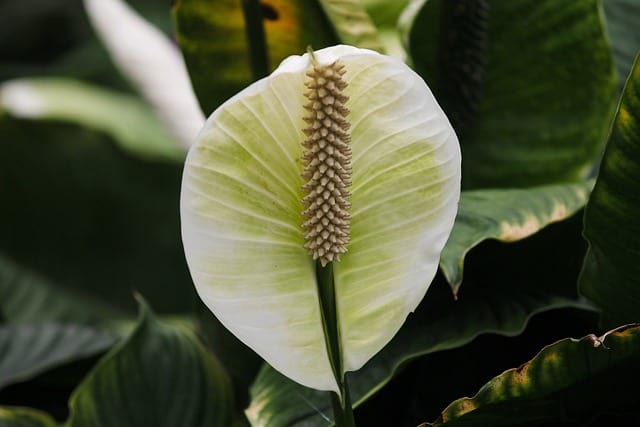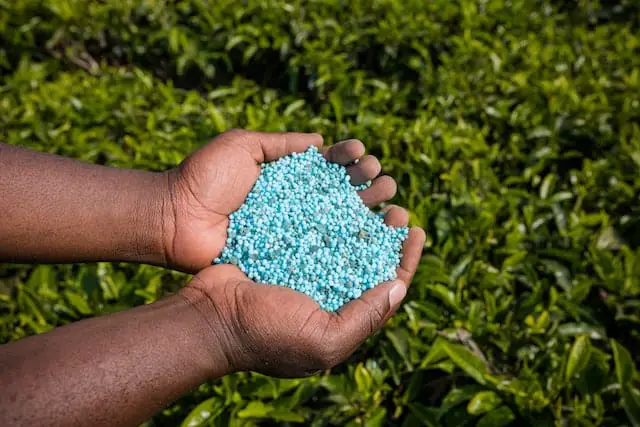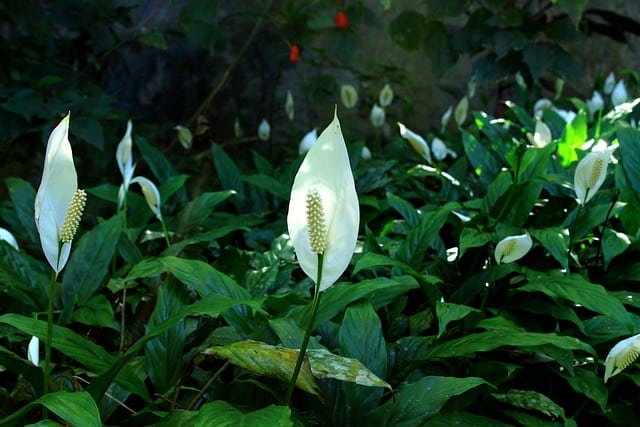Peace lilies are a popular houseplant known for their lush green leaves and beautiful white flowers. However, one common issue that many peace lily owners face is the appearance of brown spots on the leaves. These brown spots on leaves of peace lily can be unsightly and may indicate that the plant is not receiving the proper care it needs to thrive.
Understanding peace lilies is important in identifying the cause of brown spots on their leaves. Peace lilies are native to tropical rainforests, and as such, they require a warm and humid environment to grow well.
They also prefer indirect sunlight and moist soil. If these conditions are not met, the plant may develop brown spots on its leaves.
Key Takeaways
- Brown spots on peace lily leaves are a common issue that can indicate the plant is not receiving the proper care it needs to thrive.
- Understanding peace lilies is important in identifying the cause of brown spots on their leaves.
- Effective treatment methods for brown spots on peace lilies include removing damaged leaves, adjusting the plant’s environment, and using fungicides or insecticides when necessary.
You shouldn’t miss on these other top posts:
- Brown Spots on Leaves of Fiddle Leaf Fig
- Brown Spots on Kalanchoe Leaves
- Brown Spots on Jasmine Leaves
Understanding Peace Lily

Peace lily is a tropical plant that belongs to the Spathiphyllum spp. family. It is a popular houseplant among indoor gardeners due to its attractive foliage and ability to purify the air.
Peace lilies are easy to care for and can thrive in low light conditions, making them an excellent choice for those who want to add some greenery to their homes.
The leaves of peace lilies are large, glossy, and dark green. They can grow up to 6-8 inches long and 3-5 inches wide. The plant produces white or cream-colored flowers that resemble calla lilies. Peace lilies are known for their ability to remove harmful toxins from the air, making them an excellent addition to any home or office.
While peace lilies are relatively easy to care for, they can develop brown spots on their leaves, which can be a cause for concern among indoor gardeners. Brown spots on peace lily leaves can be caused by a variety of factors, including over or underwatering, too much or too little light, pests, and diseases.
To keep peace lilies healthy and free from brown spots, it is essential to provide them with the right growing conditions. Peace lilies prefer bright, indirect light and should be watered when the soil is dry to the touch.
Overwatering can lead to root rot, which can cause brown spots on the leaves. On the other hand, underwatering can cause the leaves to wilt and turn brown.
Recognizing Brown Spots
Peace lilies are popular houseplants that can add a touch of greenery to any indoor space. However, like any other plant, peace lilies can develop brown spots on their leaves, which can be a sign of an underlying problem. Recognizing brown spots on peace lily leaves is crucial to identifying and addressing the issue.
Brown spots on peace lily leaves can appear in different forms, such as streaks, margins, or lesions. They can also occur on the leaf tips, resulting in brown leaf tips or brown leaves. The appearance and location of the brown spots can provide clues as to what is causing the problem.
One common cause of brown spots on peace lily leaves is environmental stress. Over or under watering, exposure to strong sunlight, or fluctuations in temperature or humidity can all lead to brown spots. In such cases, the brown spots may be limited to the outer edges of the leaves or the leaf tips.
Another possible cause of brown spots on peace lily leaves is pest infestation. Spider mites, mealybugs, and scale insects can all cause brown spots on leaves, along with other symptoms such as webbing, sticky residue, or distorted growth.
Fungal or bacterial diseases can also cause brown spots on peace lily leaves. In such cases, the brown spots may be accompanied by other symptoms such as yellowing, wilting, or blackening of the leaves. Proper diagnosis is crucial to identifying the specific disease and applying the appropriate treatment.
Common Causes of Brown Spots

The peace lily is a popular houseplant that is known for its lush green foliage and white flowers. However, brown spots on the leaves can be a common problem for peace lily owners. There are several reasons why brown spots may appear on the leaves of a peace lily.
One of the most common causes of brown spots on peace lilies is environmental stress. This can be caused by over or under watering, exposure to direct sunlight, or fluctuations in temperature or humidity.
Peace lilies prefer indirect light and a humid environment, so it is important to keep them away from windows or heat vents that may cause them to dry out.
Another possible cause of brown spots on peace lilies is pest infestation. Mealybugs and spider mites are common pests that can cause brown spots on the leaves of a peace lily. It is important to identify and treat any pest infestations as soon as possible to prevent further damage to the plant.
Overwatering or underwatering can also cause brown spots on the leaves of a peace lily. It is important to maintain a consistent watering routine and ensure that the plant is not sitting in water. Peace lilies prefer a well-draining potting mix and may require repotting if the soil becomes too compacted or retains too much moisture.
Finally, brown spots on peace lilies can also be a sign of disease. Fungal leaf spot disease and root rot are two common diseases that can cause brown spots on the leaves of a peace lily. It is important to identify the disease and treat it promptly to prevent further damage to the plant.
Effective Treatment Methods
Brown spots on peace lily leaves can be a sign of various issues, including overwatering, underwatering, exposure to direct sunlight, and chemical burns. Fortunately, there are several effective treatment methods that can help revive your plant’s health.
1. Watering and Fertilization

Watering and fertilization are two crucial factors that can impact the health of your peace lily. Overwatering can lead to root rot and cause brown spots on the leaves, while underwatering can cause the leaves to wilt and turn brown.
It is recommended to water the plant once a week and ensure that the soil is well-draining. Bottom watering is also a good option to prevent waterlogging.
Peace lilies are sensitive to the type of water they are exposed to. Using distilled water or filtered water is recommended as tap water can contain chemicals that can cause brown spots on the leaves.
Fertilization should be done once a month during the growing season with a balanced fertilizer. Overfertilization can also cause brown spots on the leaves, so it is important to follow the recommended dosage.
2. Humidity and Lighting
Peace lilies thrive in high humidity environments, so misting the leaves with water or placing a tray of water near the plant can help maintain the required humidity level.
Exposure to direct sunlight can cause brown spots on the leaves, so placing the plant in indirect or filtered light is recommended. Fluorescent lighting can also be used as an alternative to natural light.
3. Soil and Repotting
Peace lilies prefer well-draining soil that is rich in organic matter. Using a potting mix that contains peat moss, perlite, and vermiculite can help maintain the required soil moisture and drainage. Repotting the plant every two years is recommended to prevent overcrowding and ensure healthy growth.
4. Pest Control
Pests such as spider mites and mealybugs can also cause brown spots on peace lily leaves. Using neem oil or insecticidal soap can help control these pests without harming the plant. It is important to follow the recommended dosage and frequency of application to prevent any adverse effects on the plant.
Preventive Measures for Brown Spots
Peace lilies are susceptible to brown spots on their leaves, which can be caused by a variety of factors. Fortunately, there are several preventive measures that can be taken to keep this issue at bay.
1. Proper Care
One of the most important preventive measures for brown spots on peace lilies is proper care. This includes ensuring that the plant is receiving enough water, fertilizer, and indirect light. Peace lilies prefer to be kept in a humid environment, so misting the leaves regularly can also help prevent brown spots from forming.
2. Watering and Soil

Watering and soil are also important factors to consider when preventing brown spots on peace lilies. Overwatering can lead to root rot, which can cause brown spots on the leaves.
It’s important to ensure that the soil is well-draining and that the plant is not sitting in water. Bottom watering can be an effective way to ensure that the plant is getting enough water without risking overwatering.
3. Water Quality
The quality of the water used to water peace lilies can also play a role in preventing brown spots. Chlorine and other chemicals in tap water can be harmful to the plant, so using distilled or filtered water can be a good option.
4. Repotting
Repotting peace lilies every few years can also help prevent brown spots from forming. This allows for fresh potting soil and better drainage, which can help prevent overwatering and root rot.
5. Insect Control
Insects such as aphids and spider mites can also cause brown spots on peace lily leaves. Using insecticidal soap or neem oil can help control these pests and prevent brown spots from forming.
By following these preventive measures, peace lily owners can help keep their plants healthy and free from brown spots on the leaves.
Frequently Asked Questions
How do you treat brown tips on peace lily?
If your peace lily has brown tips, it could be due to over-fertilization, over-watering, or low humidity. To treat brown tips, you should remove the affected leaves and ensure that you are not over-fertilizing your plant.
Make sure to water your peace lily only when the soil feels dry to the touch, and use a humidifier or place a tray of water near the plant to increase humidity levels.
Why are my peace lilies getting brown spots?
Brown spots on peace lilies are often caused by environmental stresses, such as over or under watering, strong sunlight, or fluctuations in temperature or humidity.
Other possible causes include pests, diseases, or nutrient deficiencies. To prevent brown spots, make sure to provide your peace lily with consistent and appropriate care, including proper watering, lighting, and fertilization.
Why does my peace lily have brown and yellow spots?
Brown and yellow spots on peace lilies can indicate a fungal or bacterial infection, which can be caused by over-watering, poor drainage, or high humidity levels.
To treat brown and yellow spots, you should remove the affected leaves and improve the plant’s growing conditions. Make sure to water your peace lily only when the soil feels dry to the touch, and avoid getting water on the leaves or flowers.
What does fungus on a peace lily look like?
Fungal infections on peace lilies can appear as brown, yellow, or black spots on the leaves, stems, or flowers. The affected areas may also become soft and mushy, and the plant may wilt or die.
To prevent fungal infections, make sure to provide your peace lily with proper growing conditions and avoid over-watering or allowing water to sit on the leaves or flowers.
How do you care for a peace lily indoors?
To care for a peace lily indoors, you should place it in a bright, indirect light and water it only when the soil feels dry to the touch. Make sure to avoid over-watering or under-watering, and use a humidifier or place a tray of water near the plant to increase humidity levels.
You should also fertilize your peace lily every few months with a balanced, water-soluble fertilizer.
How do you get rid of brown spots on peace lilies?
To get rid of brown spots on peace lilies, you should remove the affected leaves and improve the plant’s growing conditions. Make sure to water your peace lily only when the soil feels dry to the touch, and avoid getting water on the leaves or flowers.
You can also use a fungicide or insecticide if necessary, but make sure to follow the instructions carefully and avoid using too much.

Hey, I’m Lisa and I’ve been an avid gardener for over 30 years. I love writing, talking and living in the garden! Feel free to connect with me on my socials below

